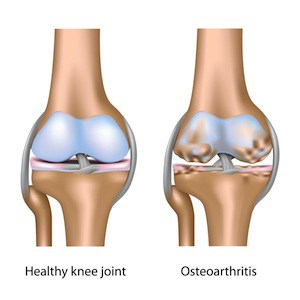Latest research conducted by a team of scientists at the University of Bristol shows that there are signs of an omega 3 osteoarthritis link.
How so? Osteoarthritis seems to be greatly reduced by the intake of Omega 3 found in fish oils. The study points that the difference fish oil omega 3 makes to symptoms of osteoarthritis are both significant and substantial.
How the Omega 3 Osteoarthritis Connection Works
Osteoarthritis (or degenerative joint disease) is a type of arthritis where there is a breakdown and eventual loss of cartilage in one or more joints of our limbs. The cause of the disease is not yet known. However, wear and tear of joints, heredity, obesity and occurrence of fracture could trigger the condition. The treatment is limited to pain relief and joint replacement. (1)
The University of Bristol study (funded by Arthritis Research UK) was published in the journal Osteoarthritis and Cartilage. The report said that Omega 3 even if not sourced from fish oil but sources such as flax oil helped retard the advancement of osteoarthritis in high risk patients. Omega 3’s confirmed role in both slowing down and preventing the cartilage condition through research puts to rest the myth-value accorded to Omega 3’s benefits for attaining good joint health.
The early signs that develop before the symptoms are experienced by a person include degradation of collagen in cartilage and the loss of molecules that give it shock-absorbing properties. Both these conditions were significantly reduced with the administration of Omega 3. (2)
As per the lead researcher, Dr. John Tarlton, (PhD and senior research fellow from the Matrix Biology Research group at the University of Bristol’s School of Veterinary Sciences), “Furthermore, there was strong evidence that omega-3 influences the biochemistry of the disease, and therefore not only helps prevent disease, but also slows its progression, potentially controlling established osteoarthritis”. (3)
Osteoarthritis affects as many as 50 million people in the US alone and 1 in five adults are estimated to be suffering from the condition. It is estimated that by 2030, as many as 67 million adult Americans could have osteoarthritis given the current rate of progress of the disease. (4)
 Though the study was conducted on guinea pigs, it is considered to be the most apt model to study spontaneous, naturally occurring osteoarthritis in humans. In ginuea pigs the evidence supporting the use of Omega 3 to retard or prevent the onset of this condition was found to be very strong.
Though the study was conducted on guinea pigs, it is considered to be the most apt model to study spontaneous, naturally occurring osteoarthritis in humans. In ginuea pigs the evidence supporting the use of Omega 3 to retard or prevent the onset of this condition was found to be very strong.
Why Your Omega 3 to Omega 6 Ratio Matters
Based on the exciting findings of the study, Dr. Tarlton encouraged people to follow government guidelines (U.K) on the intake of Omega 3. There is no formal recommended daily intake for omega fatty acids but it is widely held that omega 3 to omega 6 ratio should be 1:3. (5) The current popular view is an appropriate intake of 17 grams a day for men and 12 grams a day for women of Omega 6 fatty acid. Similar accepted views for Omega 3 are 1.6 grams a day for men and 1.1 grams a day for women.
As per Dr. Tarlton, “Most diets in the developed world are lacking in omega-3, with modern diets having up to 30 times too much omega-6 and too little omega-3. Taking omega-3 will help redress this imbalance and may positively contribute to a range of other health problems such as heart disease and colitis.” However, more studies need to be conducted to confirm the effect of omega 3 fatty acids on human osteoarthrisits. (6)
SOURCES:
- Osteoarthritis – Causes, Incidence and Risk Factors; PubMed; October, 2011;
http://www.ncbi.nlm.nih.gov/pubmedhealth/PMH0001460/ - Omega-3 Fatty Acids Shown to Prevent or Slow Progression of Osteoarthritis; Science Daily; October, 2011;
http://www.sciencedaily.com/releases/2011/10/111017111600.htm - Omega-3 Fatty Acids Shown To Prevent Or Slow Progression Of Osteoarthritis; University of Bristol; October, 2011;
http://www.bristol.ac.uk/news/2011/7969.html - Arthritis Related Statistics – Prevalence of Arthritis; Centres For Disease Prevention And Control; October 2011;
http://www.cdc.gov/arthritis/data_statistics/arthritis_related_stats.htm - What Is The Omega 3 Omega 6 Ratio And Why Do We Need To Know? Livestrong.com; October, 2011;
http://healthyomega3.com/omega-3-omega-6/ - Regulation Of Osteoarthritis By Omega-3 (N-3) Polyunsaturated Fatty Acids In A Naturally Occurring Model Of Disease;
Osteoarthritis and Cartilage; October, 2011;
http://www.oarsijournal.com/article/S1063-4584(11)00164-6/abstract





Article Comments